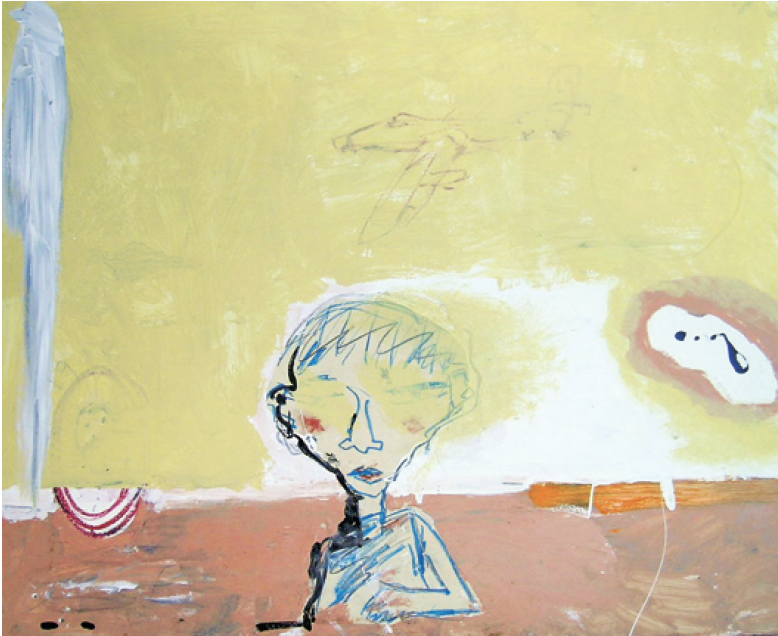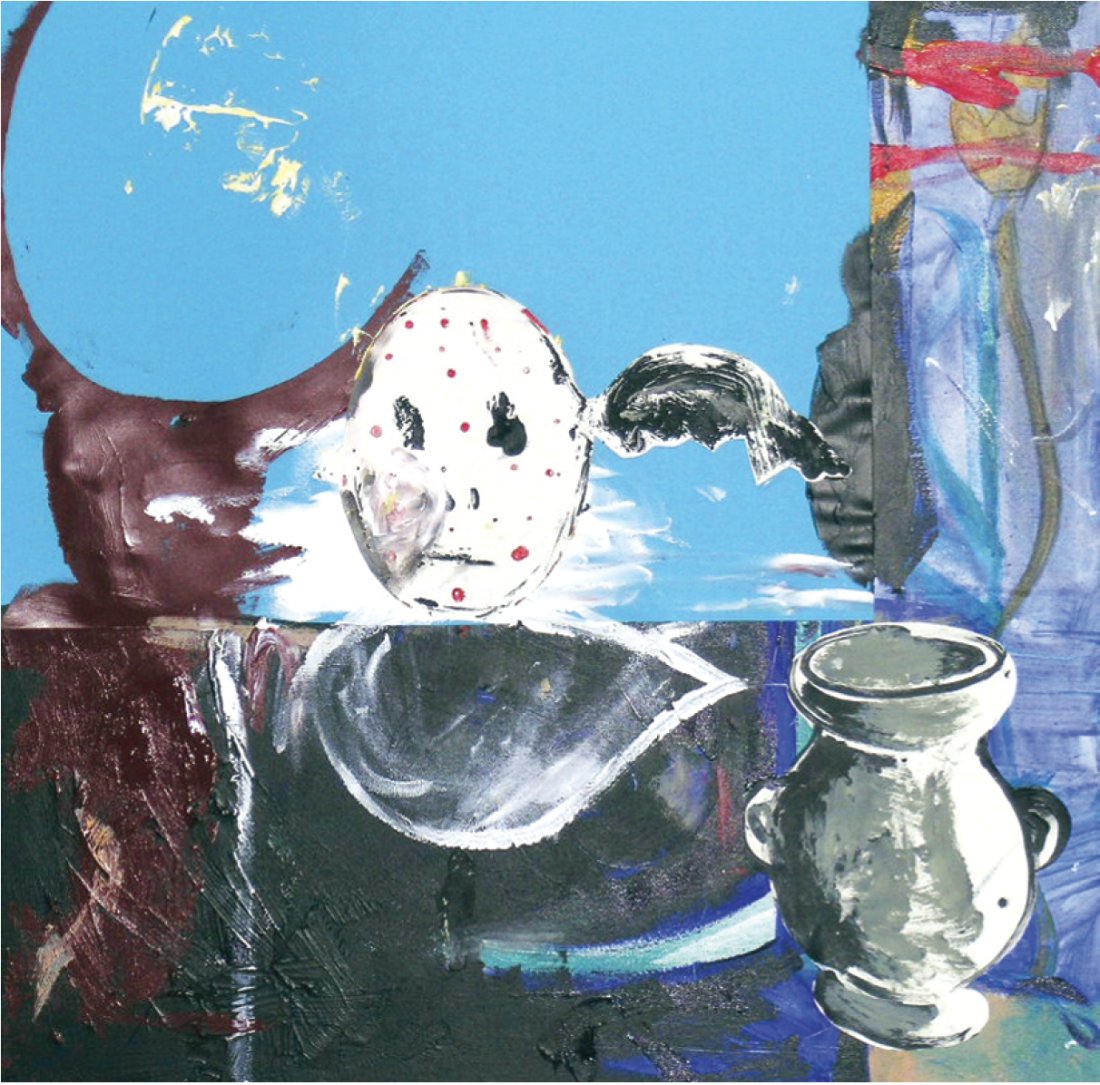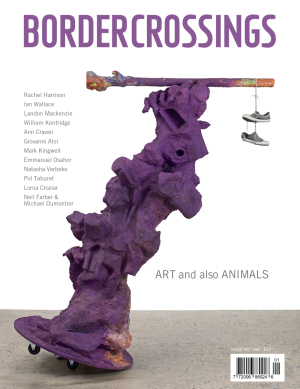Iron Men: New Painting
The invitation for “Iron Men,” an exhibition of collaborative paintings by Toronto artists Matthew Varey, Gary Michael Dault and John Scott, features a work entitled Urn, 2005, a multi-layered, mixed-media piece with a striking blue sky and, at its centre, a ghostly mask reminiscent of Scott’s famous Twister figure. Fittingly, there is an image of an urn pasted in one corner, from which an empty cartoon text bubble emerges. A curve of brown paint in another corner evokes vestiges of a former idea. Most of the works in this exhibition show three distinct sensibilities at work: paint and images are built up, altered, erased, painted over. That Scott’s mask features as the centre of Urn is telling; his presence figures prominently throughout the paintings, although not, as one might assume, superseding the others.

Geyser, 2005, mixed media on paper on board, 33 x 41”. Photographs courtesy Peak Gallery, Toronto.
Scott was awarded the Governor General’s award for painting in 2000. His work is in the collections of the Art Gallery of Ontario and the National Gallery of Canada, which owns his best-known piece, Trans Am Apocalypse No. 2, 1993, a car onto whose black painted surface the entire Book of Revelation has been scratched with a nail. He met Gary Michael Dault while a student at the Ontario College of Art and Design in the 1970s, where Dault was teaching. An art writer and critic, Dault has written a number of books and has shown his mixed-media works at galleries in Toronto and Hamilton, Ontario. Matthew Varey and Dault were introduced through Transit Gallery in Hamilton, where Varey shows, and where he first approached Dault with an idea. Like many ambitious young artists, Varey is exploring ways of broadening his artistic reach. In looking to increase opportunities for himself, he was inspired by what he viewed as the “great business model” of musical artists who had benefitted from organizing their own events, and he set out to find the right partners. He saw something, he says, in Dault’s work and his persona with which he identified. At Dault’s suggestion, Scott (whose work Varey had long admired) joined the group, and a trio was born.
According to Varey, the process of making the work happened organically. Canvases, brushes and colours were brought into the studio, and, from initial tentative mark making (neither Scott nor Dault had previously worked on canvas), one long, four-part painting was created. It was later broken up into individual works, one of which is Urn. While Varey insists on the experimental aspect of the collaboration, there is little doubt that Dault’s status as a well-known critic and Scott’s renown will help to interest galleries in showing the work, perhaps facilitating the group’s goal of having a cross-country show in 2007– 08. The process revealed many commonalities in both the personal and professional lives of the three—fragile egos beleaguered by expectations of success. This often comes through in the sensitively balanced work and in the more specific themes of mythology, tragedy, technology, the heroic venture and the inability to connect. In Portal, a satellite hovers alone at the centre of the canvas, its spidery shape scratched into black paint, revealing flashes of red underneath. In the palimpsestlike Geyser, a scratchy drawing of a man is surrounded by a cloud of fog, an obscured airplane suddenly overhead. When My Head Dies presents a severed head reminiscent of the heroic, doomed Macbeth, isolated in a grey square, beyond which squints a torn yellow figure, wanting to help but seemingly unable to.

Urn, 2005, mixed media on canvas, 30 x 30”
Despite the differences in age and background, or perhaps because of them, the “Iron Men” work is unarguably collaborative, with each painter acquiescing to the work as a whole, such that most pieces are pleasing “physical conversations” in paint, each a multi-layered process of discovery. In this, the works succeed where collaborations often fail. Collaboration as a process of working has many historical precedents, ranging in the recent past from the Surrealist Exquisite corpse works of the 1920s to the Singing Sculpture and other works of Gilbert and George, to paintings by Warhol and Basquiat. Its appeal as a strategy lies in the disconnect between the artist’s personal identity and his production. As Charles Green noted in The Third Hand: Collaboration in Art from Conceptualism to Post Modernism, the process of collaboration creates a distance, where the artist is less an individual creator and more a tool of creation. There is certainly a compatibility of interests among the Iron Men. Although the work seems to suffer at times from lack of clarity, the most successful paintings in this somewhat uneven show do well in uniting bleak isolation with a palpable sense of camaraderie and trust. The title “Iron Men” ends up being rather incongruous, and yet strangely appropriate, for a show that is less about the prowess of the individual than his fallibility, and the strength to be gained from the presence of others. ■
“Iron Men: New Painting” was exhibited at Peak Gallery in Toronto from October 12 to November 5, 2005.
Andrea Carson writes on contemporary art, architecture and design from Toronto.

